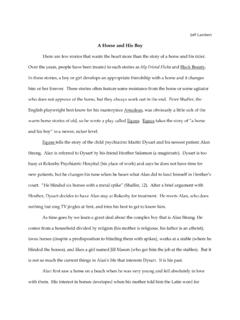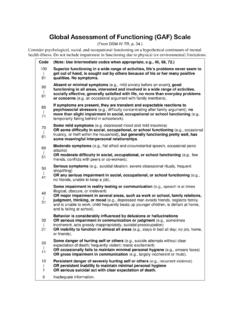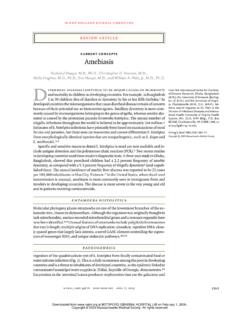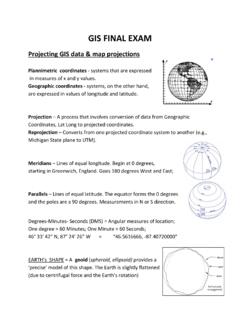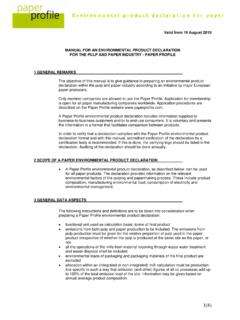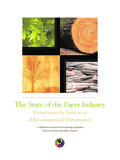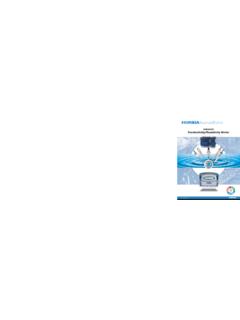Transcription of Product Environmental Life-Cycle Assessment …
1 Copyright 2000 by the MassachusettsInstitute of T echnology and Yale UniversityV olume 3, Number 2 & 3yR E S E A R C H A N D A N A LY S I SJournal of I nd ustrial Ecology95Pr oduct EnvironmentalLife- cycle Assessment UsingInput-Output T echniquesSatish JoshiJames Madison CollegeMichigan State UniversityEast Lansing, MI USAySummaryLife- cycle Assessment (LCA) facilitates a systems view inenvironmental evaluation of products, materials, and pro-cesses. Life-Cycle Assessment attempts to quantify environ-mental burdens over the entire Life-Cycle of a Product fromraw material extraction, manufacturing, and use to ultimatedisposal.
2 However, current methods for LCA suffer fromproblems of subjective boundar y definition, inflexibility,high cost, data confidentiality, and paper proposes alternative models to conductquick, cost effective, and yet comprehensive Life-Cycle as-sessments. The core of the analytical model consists of the498 sector economic input-output tables for the augmented with various sector-level environ-mental impact vectors. The Environmental impacts cov-ered include global warming, acidification, energy use,non-renewable ores consumption, eutrophication, conven-tional pollutant emissions and toxic releases to the envi-ronment.
3 A lternative models are proposed forenvironmental Assessment of individual products, pro-cesses, and Life-Cycle stages by selective disaggregation ofaggregate input-output data or by creation of hypotheticalnew commodity sectors. T o demonstrate the method, acase study comparing the Life-Cycle Environmental perfor-mance of steel and plastic automobile fuel tank systems fuel tanksdesign for environment (DfE)input-output analysisISO 14000life- cycle Assessment (LCA) Product evaluationAddress correspondence to:Satish Joshi313 Case HallJames Madison CollegeMichigan State UniversityEast Lansing, MI 48824 E S E A R C H A N D A N A LY S I S96J ou r nal of In dustr ial EcologyIntroductionEnvironmentally conscious decision makingrequires information about Environmental conse-quences of alternative products, processes or ac-tivities.
4 Life-Cycle Assessment (LCA) is asystematic tool to analyze and assess environmen-tal impacts over the entire life cycle of involves tracing out the major stages andprocesses involved over the life cycle of a productcovering: raw materials extraction, manufactur-ing, Product use, recycling and final disposal,identifying and quantifying the environmentalimpacts at each stage. The goal of LCA is to fa-cilitate a systems view in Product and processevaluation (Lave et al. 1995; Miettinen andHamalainen 1997; Keoleian and Menerery 1993).The LCA approach is widely recognized as auseful framework and attempts are underway tointegrate Life-Cycle thinking into business deci-sions.
5 A major international initiative in thisdirection is the series of Environmental manage-ment standards (EMS) proposed by the Interna-tional Standards Organization, widely known asISO 14000. Standards being developed for in-clusion under ISO 14000 include principles andguidelines for conduc ting LCA for productevaluation (T ibor and Feldman 1996). Similarly,the document Guidance on acquisition of envi-ronmentally preferable products and services, prepared by the United States EnvironmentalProtection Agency ( EPA) to help imple-ment the President s Executive order 12873, rec-omm ends LCA approa ch in a ll federalprocurem ent ( EPA 1995c ; Vigon et a ).
6 Many eco-labeling and Product take backregulations in Europe require Life-Cycle environ-mental analysis of products (Davis 1993).Although conceptually simple and appealing,LCAs are difficult to carry out in reality. Produc-tion of most typical products and materials re-quires a large number of diverse inputs, which inturn use many other inputs in their there are interdependencies in inputs,which have to be modeled. Attempting to traceall the direct and indirect inputs and associatedenvironmental burdens all the way to ultimateraw material extraction becomes an unwieldyexercise. For example, steel making requires alarge number of inputs including iron ore, lime-stone, coke, electricity, chemicals, alloys, rail-road services, compute r support, and so on,which in turn draw on resources from almost allsectors of the economy, including the steel in-dustry.
7 In order to keep the analysis tractable,most LCAs limit the scope of analysis only to themajor inputs at each stage, leading to problemsof subjective boundary definition and compara-bility across studies. Moreover, data on input re-quirements and emissions for even suchtruncated LCAs have to be collected from a largenumber of different suppliers leading to highcost, time, and issues of data confidentiality andverifiability. As a result, LCA is considered aflawed tool that cannot deliver what it promises(Portney 1993; Arnold 1993; Lave et al. 1995).T o address the problem of subjective bound-ary definition in conventional LCA, Lave andcolleagues proposed using economic input-out-put analysis te chniques in LCA (La ve e t ).
8 Economic input-output Life-Cycle assess-ment (EIO-LCA) takes a top-down approachand treats the whole economy as the boundaryof analysis. Another strength of EIO-LCA ap-proach is that economy-wide interdependenciesin inputs are modeled as a set of linear simulta-neous equations. Although less common andlimited in scope, the representation of input in-terdependencies as systems of equations can befound elsewhere in the LCA literature. For ex-ample, Pento constructs input-output matricesfor the paper industry in his dynamic life -cycleinventory modeling (Pento 1997). Similarly, thecommercially available KCL-ECO LCA pro-gram represents Product Life-Cycle inventory as aset of linear equations of physical quantities(Karna and Engstrom 1994).
9 Lave and colleagues implement their eco-nomic input-output Life-Cycle Assessment (EIO-LCA) model using 498 498 commodity sectordirect re quirem ents matrix published by Department of Commerce as a part of the1987 input-output tables ( Commerce1994). They augment the direct requirementsmatrix with sector-level toxic release emissionfactors and electricity use intensity. They ap-proximate the Product , whose LCA is required,by the corresponding commodity sector. For ex-ample, in comparing the Life-Cycle environmen-tal burdens of paper cups and plastic cups, theyJos hi, Product In put-Out put L ife- cycle Assessment97R E S E A R C H A N D A N A LYS I Syapproximate paper cups by the industry sector Paperboard Containers and Boxes and plasticcups by the industry sector Plastic Materialsand Resins.
10 The Life-Cycle toxic emissions andelectricity use from paper cup and plastic cupproduction are approximated by economy-wideimpacts to meet a given incremental final de-mand of the corresponding commodity , as proposed, leads to a consistentboundary definition. However, it is still subjectto several well-recognized limitations (Lave etal. 1995). First, the Product of interest is ap-proximated by its commodity sector in the na-tional input-output tables with respect to inputrequirements and Environmental the commodity sectors in the national in-put-output tables are broad aggregates that in-clude a large number of products.

